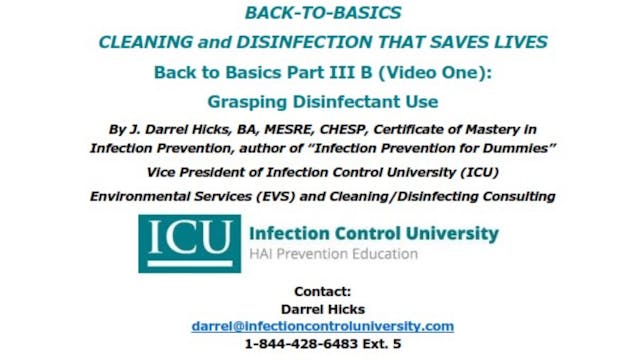Back to Basics Part III A: Choosing and Using Disinfectants
Back to Basics: Cleaning/Disinfection Saving Lives
•
7m 2s
To Be Clear…It’s a Two-step Cleaning and Disinfecting Process
Many cleaning professionals have heard that a surface must be cleaned before applying a disinfectant. However, they might not know exactly why.
But before explaining the reasons, it will help to identify the differences between cleaning and disinfecting.
According to the Centers for Disease Control and Prevention (CDC), here is how these terms are defined:
Cleaning removes germs, dirt, and impurities from surfaces or objects.
Disinfecting kills germs on surfaces or objects.
But these definitions do not tell us why cleaning must be done before a surface can be disinfected, often referred to as the "two-step" process.
The following explanations from leading health and safety sources can help explain why the two-step process is necessary.
The CDC explains it this way:
[Cleaning] does not necessarily kill germs, but by removing them, it lowers their numbers and the risk of spreading infection. . . .
[Disinfecting] does not necessarily clean dirty surfaces or remove germs, but by killing germs on a surface after cleaning, it can further lower the risk of spreading infection.
A publication on the U.S. Environmental Protection Agency website states:
Clean first before you disinfect. Germs can hide underneath dirt and other material on surfaces where they are not affected by the disinfectant. Dirt and organic material can also reduce the germ-killing ability of some disinfectants.
The Food Standards Agency (FSA), serving England, Wales, and Northern Ireland, claims:
Chemical disinfectants only work if surfaces have been thoroughly cleaned first to remove grease and other dirt.
Up Next in Back to Basics: Cleaning/Disinfection Saving Lives
-
Back to Basics Part III B (Video One)...
Disease-causing microorganisms often live on inanimate objects. You use disinfectants to eliminate or greatly reduce these live pathogens and help prevent
the transmission of disease. A disinfectant is intended to destroy or neutralize one or more specific microbial groups.
In most cleaning sit...
-
Back to Basics Part III B (Video Two)...
We must start with the realization that the environmental surfaces in our world (even in a patient’s room) will never be free of disease-causing pathogens, although the manufacturers of UV-C or Hydrogen Peroxide Vapor (HPV) room disinfection systems make claims to the contrary. The fact is those ...
-
Back to Basics Part III C: Demystify...
Disinfectants are designed for a specific purpose and are to be used in a certain manner.
Therefore, users SHOULD read the label carefully to ensure the correct product is selected for the intended use and applied correctly. US Federal law requires all applicable label instruction on EPA-regist...



